Python vs. C++: Which Programming Language is Best for Your 2024 Project?
If you know the context and use cases, Python vs. C++ is a simple debate to settle.
 August 21, 2023
August 21, 2023 12 minute reading
12 minute reading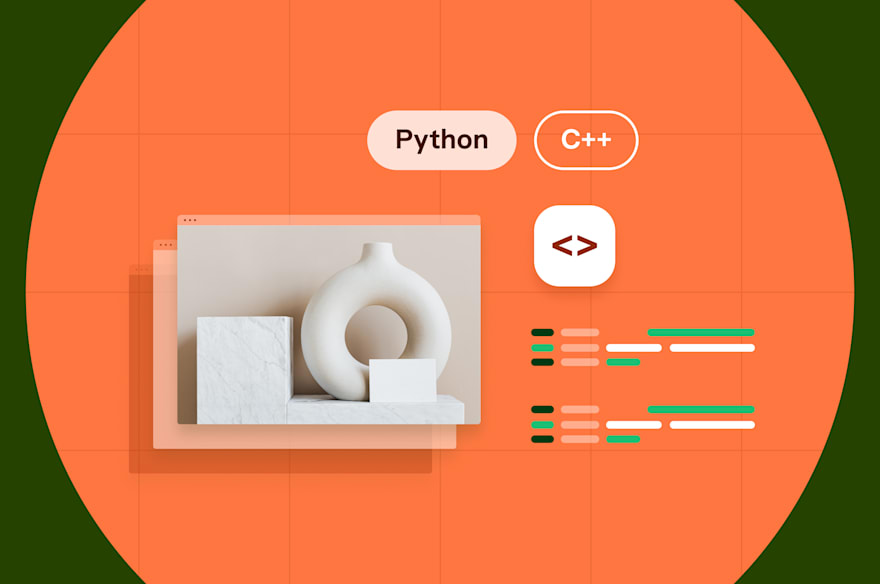
Deciding on Python vs. C++ isn’t as simple as deciding on apples vs. pears. Although there’s some intersection between these two powerful languages, many projects and use cases clearly favor one language over the other.
Many Python vs. C++ guides focus on minutiae that have little to do with real-world use cases, while others don’t consider the context. For example, if you’re programming microcontrollers, you’ll likely need to use C or C++. But if you’re programming a web app, Python is a far better candidate.
Below, instead of focusing on irrelevant comparisons, we’ll look at real-world use cases and situations to determine which language might better suit your situation.
Python vs. C++: An overview
Python and C++ have different design philosophies. C++ was developed to overcome the lack of support for classes in its predecessor—the C programming language. Python was created to be easy to learn and use.
C++ offers powerful low-level functions that let you directly manipulate and optimize computer memory. This makes it a powerful choice for resource-constrained devices. Using C++, you can optimize applications at a fine level.
This amount of fine-grained control comes at a cost, however. Slight errors in memory management can lead to a “memory leak,” where your application sucks up memory from the device until it stops working.
In more modern programming languages, such memory management is now done automatically. Code compilers and interpreters use "garbage collection" to clean up unused resources, so the programmer only has to focus on functionality.
Python includes a built-in garbage collector, so developers don’t need to worry about low-level issues.
Let’s look at the significant differences between these two languages.
Which software types are best suited to Python and C++?
The type of application you’re creating will significantly influence whether you choose Python vs. C++. For example, if you want to create an Internet of Things (IoT) device that runs on hardware with limited resources, C++ (or C) is the way to go. But if you’re creating a data analysis program that runs on the web, Python makes more sense.
C++
Programming language
Software type: System software
Suitability:
C++ is highly efficient and allows direct manipulation of computer memory.
Game development:
C++ is an excellent gaming language because of its efficiency and ability to work closely with hardware.
Embedded systems:
C++ is excellent for resource-constrained code.
Python
Programming language
Software type: Web development
Suitability:
Python is used extensively for web programming. Many frameworks exist to facilitate this, and the language’s readable syntax makes it easier to debug live applications.
Data science & AI:
Python has a rich set of libraries for machine learning (ML), natural language processing (NLP), and AI applications.
Scripting:
Python doesn’t need to be compiled. Power users can write scripts to facilitate many different tasks across platforms. Python’s extensive libraries make it easy to create scripts quickly.
For web development projects, you might also consider using JavaScript and one of its many powerful frameworks, such as Vue or Angular.
Python vs. C++: Code compilation
C++ is compiled, whereas Python is interpreted.
Compiling code means getting a program called a compiler to process the code files and translate them into machine code, a low-level language that computers can understand.
When compiling code, the compiler looks at all the code files and flags any syntactical errors. If errors exist, the compiler stops processing the files until the programmer corrects the error. Catching errors during the compilation phase means those errors don’t get deployed into live applications.
Consider the following sample C++ code to receive input from a user and then output that input to the screen. We purposely created an error on line 14 by writing Message with a capital M, as opposed to the correctly declared message variable on line 10. C++ is case-sensitive, so it won’t recognize the Message variable.
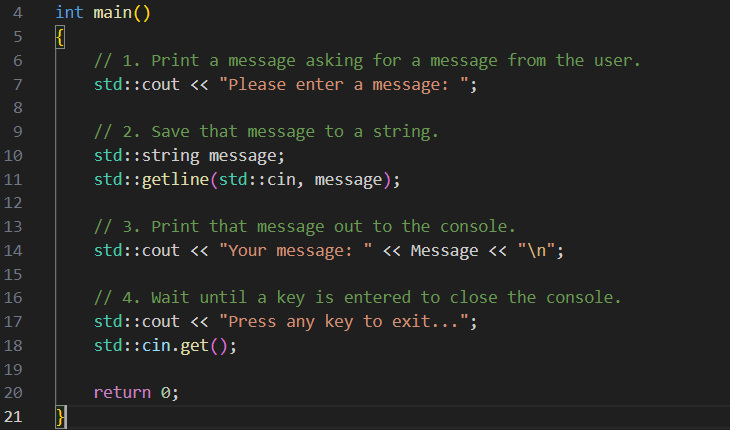
C++ code to write a message to the screen.
Before running this C++ code, we need to compile it. But when we try, we get the following error message:

C++ compile error.
Because Python isn’t compiled, we’ll only catch the error when running the program.
Here’s the equivalent code in Python:
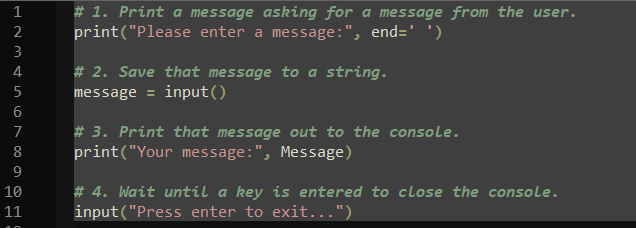
Python code to output a message from the user.
Python is also case-sensitive, so a variable with an incorrect case would also result in an error. Notice the error on line 8 where we use Message with a capital M instead of message.
When we run the script, the interpreter only catches the error when it reaches that line, because interpreted languages run line by line.

Error in Python script.
Modern development tools help solve this
This isn’t as large a problem as it once was, because modern IDEs (integrated development environments) often analyze your code files and inform you about such errors.
Some code editors will also flag the errors, as shown in the screenshot below. Visual Studio Code places a squiggly line underneath Message to indicate that it hasn’t been declared.
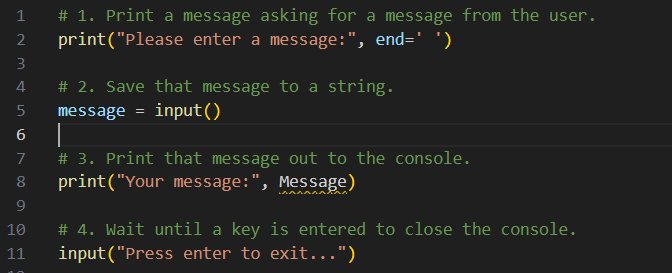
Modern development tools flag errors in the code.
Python or C++ for AI and Machine Learning (ML) applications?
Is Python better for AI/ML development than C++? The answer is it depends.
Python enjoys a vast ecosystem of ready-to-use AI and ML libraries, making it an excellent option for AI development. These libraries allow companies to create AI- and ML-centric applications fast, speeding up their time to market in a competitive landscape.
Python's easy-to-follow syntax also makes it easier to manage and change code in a vibrant startup where pressure is high, and changes can occur quickly.
But, under the hood, many Python libraries call C++ code. One article says that AI developers spend 90% of their time writing Python code, but that 99% of the CPU's time is spent executing C++ code.
Unless you create code for highly unique CPUs, you'll likely develop your AI/ML app in Python because the libraries encapsulating C++ AI code already exist. And if you need to create a super-specific C++ module, you can wrap it in Python code after completing the C++ module.
One of Python's greatest strengths is its ability to "glue" other programming languages together. This Python feature means that a system could have elements written in C++, Java, and Perl. However, developers can still use familiar Python code to call these libraries written in different languages.
The popular scientific Python libraries Scipy, Pandas, and scikit-learn, often used in AI and ML development, all use this mechanism to intermingle C and C++ with the Python code.
Some familiarity with C and C++ is necessary to leverage this Python feature to its fullest, but you’ll still write mainly in Python.
We couldn't find an official statement from OpenAI, the creators of ChatGPT, about what language they used for ChatGPT. But the most popular languages on OpenAI's GitHub page are:
Python
C++
OpenAI uses Cython for one of its GitHub projects. Cython is a Python extension that allows Python to work seamlessly with C and C++ code.
Python vs. C++: Portability
Portability refers to the ability of software to be used across different platforms without requiring much modification. Generally speaking, Python is more portable than C++, but the specifics are more complicated.
To run a Python script, you need to install the Python interpreter. You simply go to the Python website and download the Python installer for your platform. After that’s done, you can run Python scripts by calling them from the command line using the python command, such as:
python myscript.py
But this isn’t very user friendly. End users expect to download an app and then run it, not open up command prompts and type in complicated commands.
Tools like PyInstaller and cx-Freeze let you bundle your Python script into an installation file. Users can download the file and then install it like any other app. This is better for the end user but reduces portability because it requires repackaging the scripts every time you make a change.
For C++, the only way to distribute the code is in a compiled package. This often requires creating different code bases for different platforms, especially if you’re working directly with the hardware.
Python vs. C++: Community support
Developer Nation’s Q1 2023 report shows that Python has 17 million active developers, making it the second-most popular programming language in the world. The report doesn’t have numbers for C++ exclusively, but combines the total C and C++ programmers, which equals 13.3 million active developers.
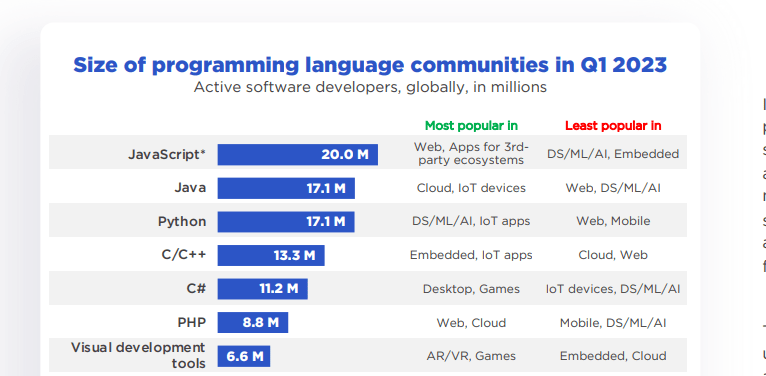
Screenshot of survey Developer Nation survey.
Python’s popularity is due largely to its usefulness in web development and its many machine learning and AI libraries. The language is currently the most sought-after programming skill by employers.
Python is also beginner-friendly, allowing more newcomers to start coding faster than they could with C++.
C++’s niche uses mean it will forever remain an influential and sought-after language, but its community is smaller. Despite that, community growth for C/C++ developers is stronger than Python’s growth, and the C/C++ community is the fourth-largest programming community in the world.
From Q1 2021 to Q1 2023, the Python community grew by 71% (from 10 million to 17.1 million), while the C/C++ community grew by 82% (7.3 million to 13.3 million).
Python vs. C++: Learning curve
Python is far easier to learn than C++, and that’s an understatement. If you’re an experienced developer, you could jump into C++ and survive. But new developers are better off first learning another language such as Java, JavaScript, or even Python.
Python follows a human-readable syntax, whereas C++ uses a C-based syntax. Java, JavaScript, C#, and PHP also follow a C-based syntax.
The C-based syntax uses curly braces to separate sections of code and semicolons to terminate lines. It also uses other somewhat cryptic language constructs that simultaneously can be challenging to learn.
Take a look at the similarities in the following languages that all follow a C-based syntax:
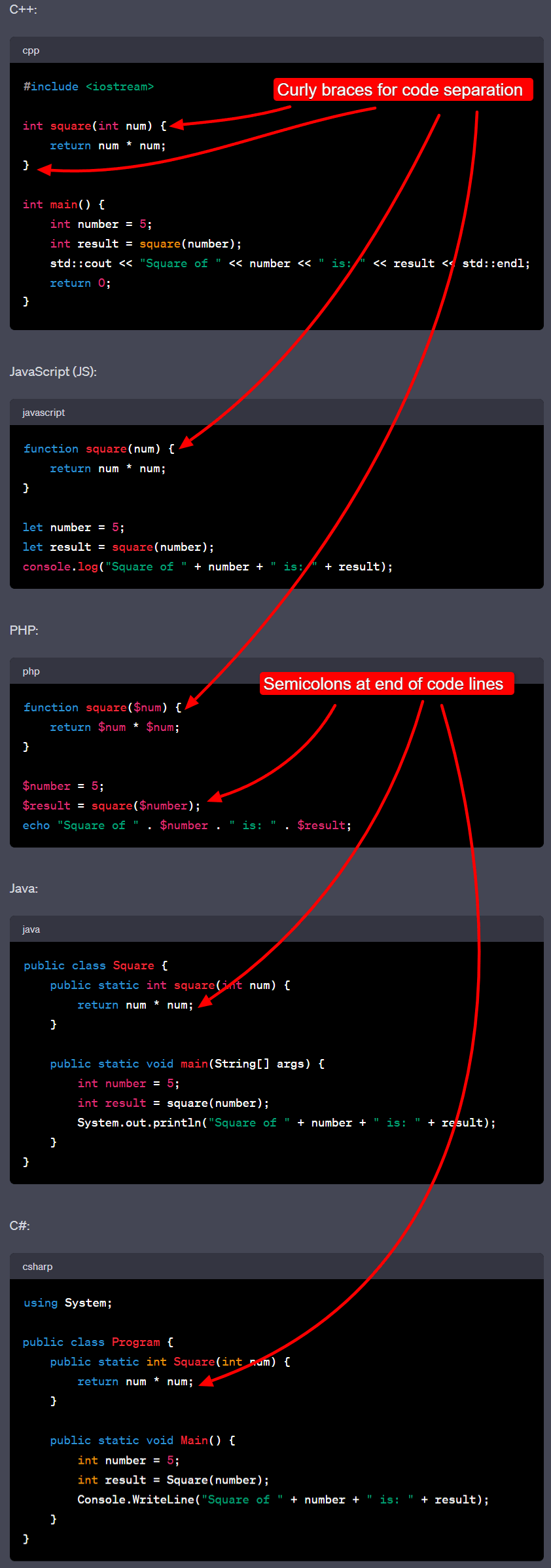
C-based syntax uses curly braces and semicolons.
The benefit of C-based syntax is that it makes it easier to learn other C-based languages. Programming languages that don’t follow the C-based rules for syntax look very different from each other, as demonstrated by the code samples for VB .Net, Python, Ruby, and Swift, below. But these languages tend to be more readable.

Examples of non-C-based syntax languages.
When learning to program for the first time, students need to know:
Basic programming concepts that are common to all languages
Syntax
Basic programming concepts are challenging to learn on their own. Adding syntax complexities to the problem makes it difficult for newcomers to dive into programming.
That’s what makes Python unique. It follows a human-readable syntax so people can focus on the programming concepts themselves and not get mired down by syntax.
Consider the following code examples and notice how the Python code is so much more readable than the C++ code:
Hello, World!
The renowned Hello, World! program requires only one line of code in Python but takes up several lines in C++.

C++ "Hello, World!"

Python "Hello, World!"
Reading user input
Reading user input is simple in Python, but doing the same in C++ requires importing libraries and resorting to hard-to-grasp language constructs.
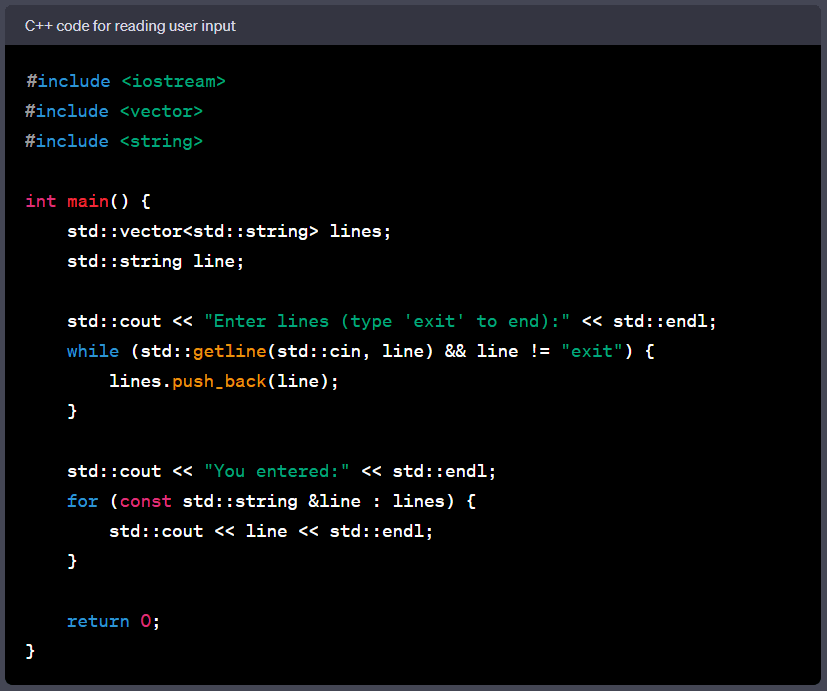
C++ reading user input.
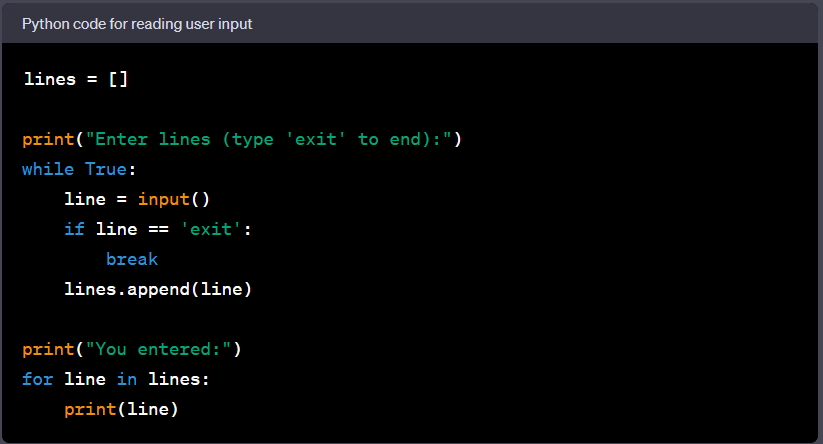
Python for reading user input.
Calculating a factorial
A factorial is a number derived from the product of the number and all the integers below it. So, the factorial of 4 is 4 x 3 x 2 x 1 = 24.
Creating a function in C++ to calculate a factorial requires verbose declarations, whereas the Python function is far more concise.

C++ code for calculating a factorial.

Python code for calculating a factorial.
Libraries and inbuilt functions
Python’s Standard Library has extensive features for achieving common tasks. For example, Python comes with libraries to achieve such things as:
Reading and processing URLs
Working with the underlying operating system
Working with date and time data
Logging
Network communication
Cryptography
C++ also has many third-party libraries that users can leverage, but Python’s libraries tend to be more user-friendly. Python’s standard library is far more extensive than C++’s.
Python vs. C++: Costs
Python and C++ are open-source languages, so no licensing fees exist. But Python allows for much faster prototyping and development, greatly reducing your time to market.
In highly competitive markets where time to market could make or break your business, choose Python unless the project specifically demands C++ technology.
Python is now even used in many IoT devices, pushing C++ out of the embedded devices market. The Raspberry Pi can run full-scale Linux OSes, and Linux natively supports Python. A project called MicroPython has a subset of the Python3 library that runs on specific microcontrollers. If the software you’re developing isn’t performance-critical, Python will get you to market a lot faster.
Previous experience
Previous programming experience plays a major role in choosing the right language for your project. Even though Python excels at web development projects, a 20-year-veteran C++ coder might feel more comfortable creating a web app entirely in C++, or at least large swaths of it.
Amazon was primarily written in C++ but has since evolved to using other languages.
Writing the software in the language you know might be cheaper than trying to learn an entirely new language. For example, in the Perl vs. Python discussion, Perl technically excels at text manipulation. But it might take a Python programmer far longer to learn Perl’s powerful text manipulation features than to write something similar in Python.
Another option would be to buy development services from C++, Python, or Perl developers for those occasional features where one language is better suited. Python can call native C/C++ code, and often does, for performance-critical elements of a larger piece of software. You could buy C++ development services for just those elements instead of learning C++ from scratch.
Python vs. C++: Mobile development
Neither Python nor C++ are excellent choices for general-purpose mobile development. The only exception is when creating games for Android. In that case, Google provides an NDK—Native Development Kit—for creating Android-specific apps or components using C++.
But game development is an advanced subject, and it’s unlikely that new programmers would get started with this as their first mobile app. If you want to create games for mobile, you’d also need to create code bases for different devices, so you’d want to hire a Swift programmer to create the same game for iOS.
It’s technically possible to create general-purpose mobile apps in Python using third-party tools such as Kivy Python or Python for Android. Still, these tools have relatively little support, and their cons outweigh their pros.
If you’re interested in creating mobile apps that work across multiple platforms, consider using one of the following frameworks instead:
: Google’s development framework for creating apps for any device using the Dart programming language
: Facebook’s framework for creating native apps for any mobile device using JavaScript
: Microsoft’s development platform for creating multi-platform apps using C#
Using ChatGPT to learn Python or C++
You can use ChatGPT to start learning Python, C++, or any other programming language. You can also use it to convert code from one language to another, such as converting C++ code to Python.
Verifying everything is the most important fact to know when using ChatGPT correctly. If you ask for a code sample, test it to ensure it works. You can also use ChatGPT for various other programming tasks.
Learning a programming language takes time and dedication. Hiring a programmer to get your immediate task done while you brush up your skills might be simpler.
Hire Python and C++ developers at Fiverr
Instead of learning Python or C++ for your project, you could order software development services from Fiverr, a leading marketplace of professional freelancing services. Fiverr sellers offer many Python development services and C++ programming services by freelancers who specialize across all major development sectors, such as:
Web development
Embedded software
Web development
Desktop development
Web services development
To find the right freelancer for your project, define your requirements, sign up for Fiverr, and browse the marketplace for freelancers who match your needs. You can search the platform through the search box or browse each category.
After making a short list, check out each freelancer’s portfolio and reviews. Contact the freelancer if you need more info, compare quotes, and then choose the freelancer you feel is best for you.
Throughout this procedure, you’re protected by Fiverr’s Safety Team to ensure you receive the best possible service.
Sign up for Fiverr today to get started.





